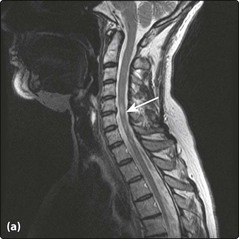Multiple sclerosis II
Differential diagnosis
Single episodes
Spinal cord syndromes
The most important differential diagnosis is spinal cord compression (Fig. 1a). In more insidious spinal cord syndromes, the differential diagnosis includes rarer spinal cord disease such as vitamin B12 deficiency, HTLV-1 myelopathy and familial spastic paraparesis. In patients lacking sensory signs, consider amyotrophic lateral sclerosis; associated lower motor neurone signs allow a distinction. After first presentation with complete transverse myelitis, patients later develop MS; those with partial spinal cord syndromes more often progress (70%).
Investigations
The investigation of a patient with suspected MS can be divided into:
Finding characteristic abnormalities
Demonstrating clinically silent lesions
MRI is particularly powerful at detecting clinically silent lesions in MS. These tend to occur in characteristic sites within the white matter: the periventricular region and corpus callosum (see Fig. 1). Similar changes can be seen in the spinal cord, though these are more commonly found when symptomatic. If a scan is enhanced with gadolinium, then active lesions can be seen; the enhancement persists for 6–8 weeks.





